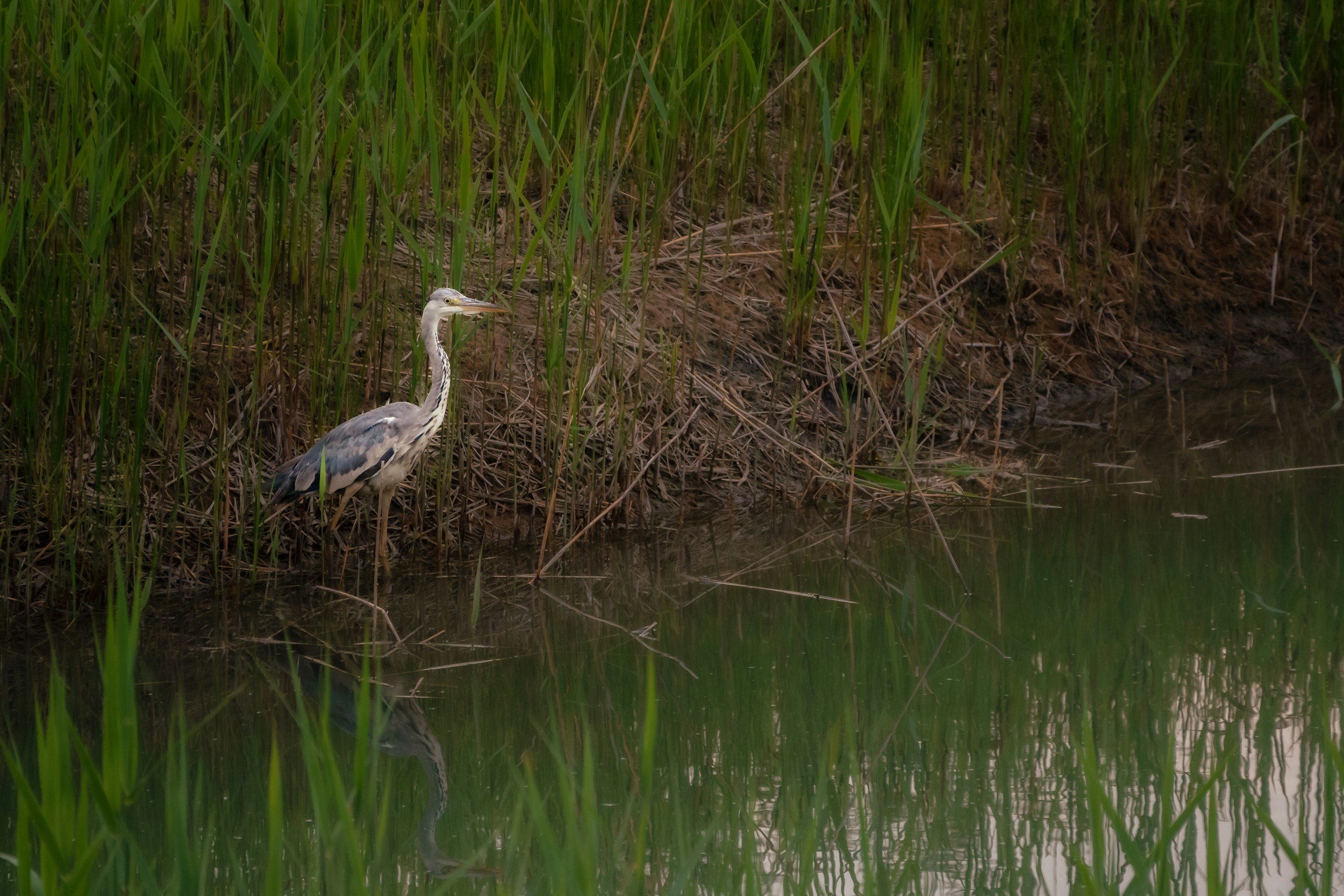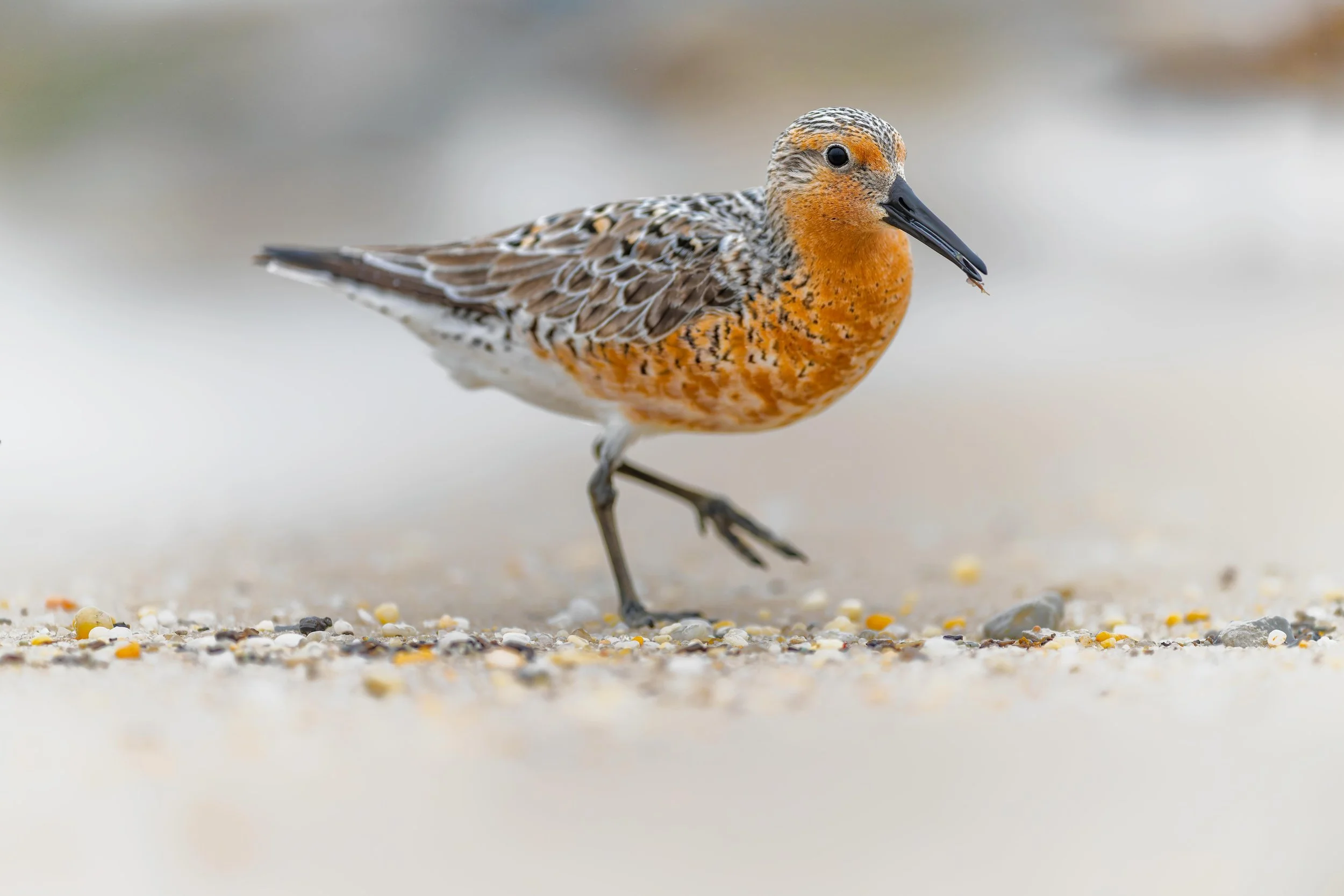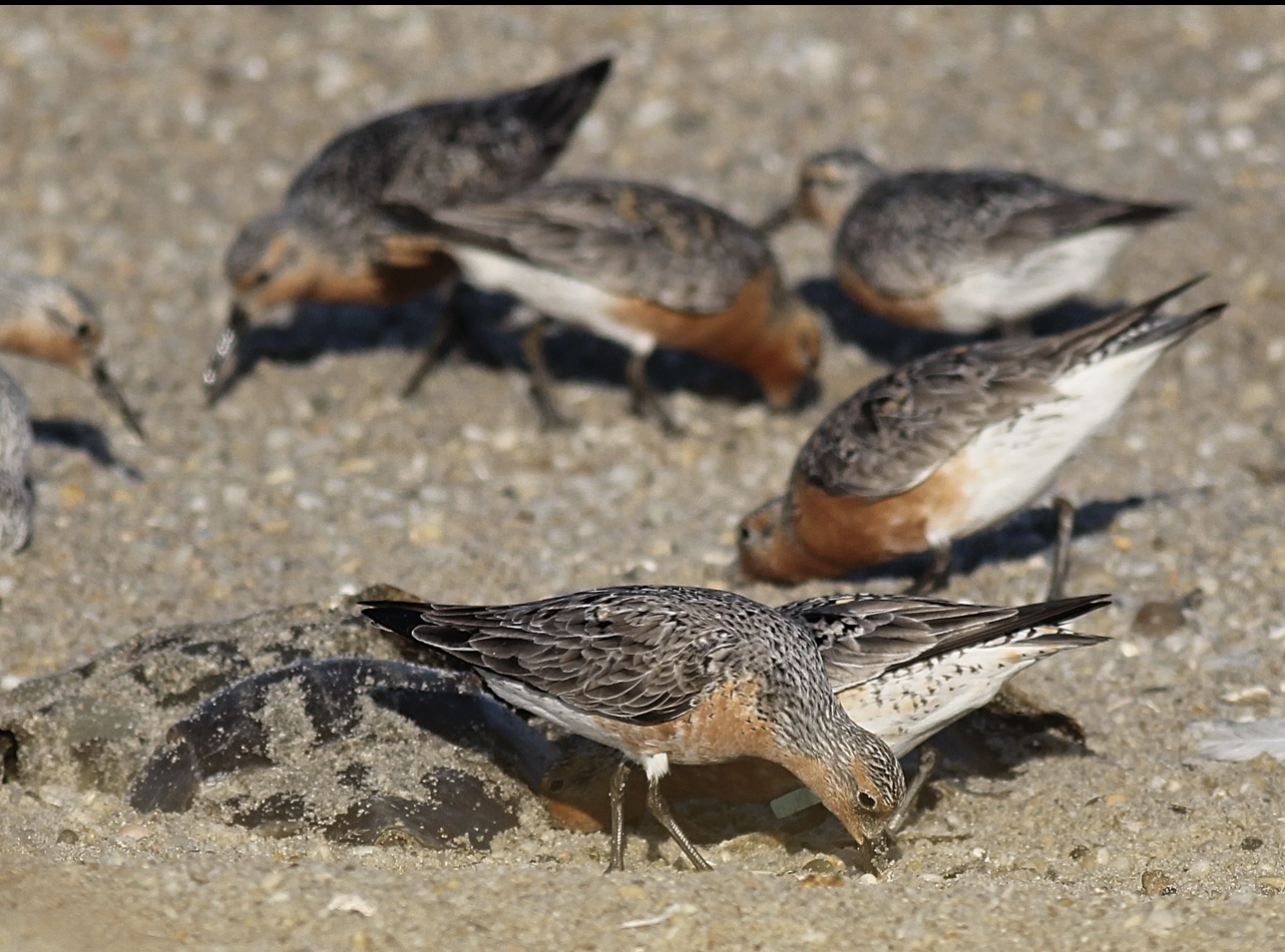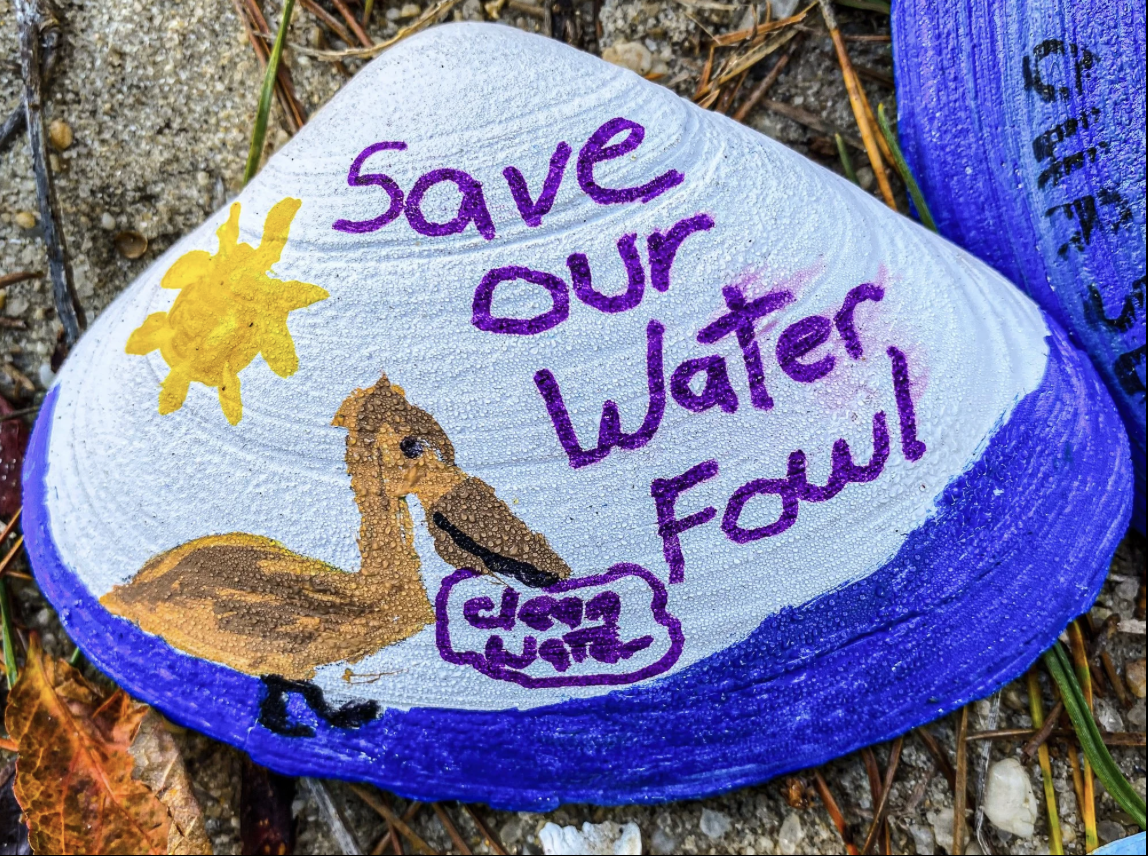SAVE SHOREBIRDS!
The migratory red knot (Calidris canutus). This species faces threats across its vast migratory range, from the tip of South America to the Arctic to nest every spring. A major threat in North America is reduced food availability, specifically the eggs of horseshoe crabs in places like Delaware Bay and along the Jersey Shore.
The Problem:
Many coastal bird populations are in decline.
Researchers estimate that the population of North American shorebirds have fallen by more than a third since 1970.
American Oystercatcher (Haematopus palliatus). The North American population of American Oystercatchers are on the 2014 State of the Birds Watch List, which lists species most in danger of extinction without significant conservation action. The American oystercatcher is a “species of special concern” in several states along the East Coast in the United States, including New Jersey, and is listed as a "yellow" species (indicating a national conservation concern) by The National Audubon Society.
Many shorebirds are vanishing visitors to the coast. With only about 217 species worldwide, shorebirds make up a rather small percentage of the more than 8,000 species of birds found on the planet. They are largely small birds, sometimes no bigger in size than the palm of your hand. To the causal coastline visitor, the birds can often be easily overlooked and out of mind.
Ignorance among the public regarding the status of shorebird populations is a sad state of affairs.
Yet, most people that visit or live near a beach or coastal wetland have probably seen some of these birds more than once. But as we change, develop and modify the coast to suit the needs of the human species, this persistent and high level of coastal destruction has thrown the migratory and nesting system for many coastal birds into grave peril.
The decline of shorebirds represents one of the top conservation crisis facing birds in the world today. Unfortunately, the examples of fading shorebird populations are everywhere, and has been for many years.
A flock of Least Terns (Sternula antillarum) observed in the Navesink River, NJ. The Least Tern is the world's smallest tern, about 9 inches in length. It is listed as an endangered species in the State of New Jersey because of human impacts on nesting and fledging areas, especially competition for recreational use of beaches.
Populations of some Shorebirds that are most in decline or have been destoyed include:
Overhunting in the late 1800s decimated the Western Hemisphere’s Eskimo curlew.
Since 1974, pectoral sandpipers have declined by more than 50 percent.
Hudsonian godwits have declined by more than 70 percent.
The bar-tailed godwit probably lost half of its global population within just the past few decades.
Populations of sanderlings, the ubiquitous shorebird of ocean beaches, have declined by as much as 80% since the 1970s.
Roseate Terns and Piping Plovers are listed under the Endangered Species Act.
Other species of terns, American Oystercatchers, and Black Skimmers have special conservation status in most Atlantic coast states.
The Spoon-billed Sandpiper and Nordmann’s Greenshank, are among the most critically endangered birds in the world.
In 2018 it was reported that the Red Knot population plummeted by 25% in a single year at Tierra del Fuego due to food shortages in Delaware Bay, NJ, a crucial feeding stopover site on their migration.
Many other coastal bird species are experiencing population declines or are facing significant threats from habitat loss and degradation.
An education sign at Barnegat Light, NJ.
Threats to coastal birds
Habitat Loss
Shorebirds Are Indicators of Healthy Ecosystems
Shorebirds are also good indicators of ecosystem health. Indicator species tell biologists how they and other creatures in the habitat are doing. For instance, a change in the shorebird population could suggest a decline in their food resources or a problem with one of the abiotic(nonliving, such as water and soil) components of the ecosystem. (Picture of a Purple Sandpiper foraging for food on a rocky coast)
By far the number one reason for populations of coastal bird species to be in decline today is due to habitat loss or destruction.
For migratory birds this includes land along routes taken by long-distance fliers. The birds traverse many different countries where conservation efforts vary, either by country, individual states, or regions that maintain relatively few protected areas, and existing ones do not overlap sufficiently with the routes of migratory birds. For example, through the early twentieth century Least Sandpipers were among the many small sandpipers shot by commercial hunters on the Atlantic coast, but their numbers recovered after the Migratory Bird Treaty Act in 1918. Today, one of their biggest conservation concerns is wetland degradation and destruction.
Migratory shorebirds need healthy habitat in at least three distinct geographic areas:
northern breeding grounds,
southern non-breeding grounds,
and stopover sites scattered along their migration routes.
Ruddy Turnstone (Arenaria interpres) in winter plumage. Despite the fact that the population trend appears to be decreasing, the decline is not believed to be sufficiently rapid to approach the thresholds for Vulnerable under the population trend criterion (>30% decline over ten years or three generations).
Stopover habitats are crucial for shorebirds to rest and refuel during migration. For example, Sanderlings, cardinal-sized sandpipers, breed in the far north and may spend their non-breeding season as far south as the southernmost tip of South America, in Tierra Del Fuego, Argentina. To successfully complete their migration, Sanderlings depend on numerous stopover sites along the Atlantic and Pacific Flyways to feed on small invertebrates and rest. They require tundra habitat for breeding, beaches and mudflats for stopover habitat, and beaches during the winter. But increasing populations along the coast lead to a demand for more land to build buildings, boardwalks, homes, and shopping centers.
Decades of poorly planned coastal development has greatly decreased prime coastal bird habitat, from wide-open wild beaches to largely managed sandy strips, from wide-open saltwater wetlands and mud flats to parking lots and roadways to strip malls and homes.
2. Climate Change
Wetlands, mudflats and beaches, which many migratory and beach nesting birds depend on for breeding, resting or feeding are in danger of changing and disappearing due to increasing sea levels, flooding, or more intense storms. Without these nesting or stop-over places, birds will have difficulties completing their long winged journeys or reproduction activities.
A piping plover nesting site flooded after an intense spring storm at Sandy Hook, NJ. The cage above the nest is to protect adult plovers and eggs from predators.
Global warming will influence the routes of migratory birds and their annual migration rhythm. Warmer spring temperatures in some regions of the world have led to an earlier arrival of many birds. For example, neotropical songbirds are arriving at their breeding areas in North America two or three weeks earlier than they did thirty years ago. Thus, they start to breed earlier. At the same time, increasing temperatures also make the vegetation bloom and insects hatch earlier. Unfortunately, these shifts are not in line with each other. The vegetation bloom and insect peak occurs even before the young birds hatch. As a result of this mismatch, the birds cannot provide enough food for their offspring. While migrants are adapted to adjust their behaviour with annual changes in the weather, the decoupling of climatic variables between geographically separate breeding and non- breeding grounds is beginning to result in mistimed migration.
In 2010, scientists Jennifer R. Seavey, Ben Gilmer, and Kevin M. McGarigal wrote an article entitled, “Effect of sea-level rise on piping plover (Charadrius melodus) breeding habitat” in the Biological Conservation journal. The article points out that climate change is raising sea levels and threatening many low-lying coastal areas and associated wildlife including piping plovers. After assessing plover habitat on the barrier islands of Suffolk County, NY, the scientists found that if plover habitat cannot migrate inward due to human development, sea level rise is likely to reduce breeding areas. Over time, the spread of eroded beaches will increase the likelihood of conflicts between plovers and human recreation. In addition, more intense storms could also limit habitat, as a large hurricane could flood up to 95% of plover habitat.
3. HUMAN TRASH & DISTURBANCE
Where beaches are protected, people often have to share space from March to September with nesting birds. Areas become closed off, which may frustrate some beachgoers and fishermen. For example, at Sandy Hook in 2009, park rangers were searching for someone who removed two incubating piping plover eggs from a nest and damaged fencing that protected shorebirds. In 2012, federal park police were trying to track down someone who stole eggs from two piping plover nests at Breezy Point during the early morning hours on July 4.
No matter how bright or colorful signs may be, some people will still enter into fenced off areas on a beach to jog or walk a dog that are clearly marked as “do not enter.” Beach closures often include a prohibition on dogs and kites. They are in place to protect breeding success for coastal birds from humans or dogs that can harm the birds by stepping on eggs or chicks. Trespassers can also cause adult birds to leave nests, exposing the eggs to very hot sand temperatures of up to 120 degrees, and can interrupt foraging activities.
4. LIMITED FOOD, INCLUDING HORSESHOE CRAB EGGS.
Limulus polyphemus (Linnaeus), the American horseshoe crab, is an ecologically important species. Horseshoe crabs are important members of food webs along the coast of the eastern United States and parts of the Gulf of Mexico. Horseshoe crab eggs are a critical component of the diet of shorebirds on their northward migration.
The birds time their arrival to perfectly coincide with annual horseshoe crab spawning in May and June. The crabs lay billions of pearly-green, caviar-sized eggs. Many of these eggs would just dry out or wash away, but instead they become a banquet for migratory shorebirds. The birds only have a short time to build up enough fat reserves to fuel the last leg of their journey up north to the Arctic to raise a family.
The dwindling Red Knot population along the Atlantic coast has been called one of the most precipitous declines of any bird species. The subspecies that occurs along the Atlantic coast once numbered 100,000-150,000, but sadly fewer than 30,000 remain today, a population drop of more than 75 percent since the 1980s. The plunge in numbers led the US Fish and Wildlife Service to list the Rufa red knot as threatened under the Endangered Species Act in 2014.
Red Knots foraging on Horseshoe crab eggs along Delaware Bay, NJ.
More than half of the total flyway population of red knots, ruddy turnstones and semipalmated sandpipers depend on horseshoe crab eggs as a rich food supply.
Unfortunately, a reduction in horseshoe crab population over the last thirty years or more has cascaded through the migratory shorebird population, who depend upon their eggs for food. While people have harvested horseshoe crabs for centuries, the yields were usually small and localized, which had little impact on horseshoe crab populations.
Currently, horseshoe crabs are harvested for bait in conch (welk) and American eel fisheries on the Atlantic Coast.
Horseshoe crabs suffered a substantial increase in harvest in the 1990s that spurred the need for management on a coast-wide scale. A combination of management efforts, research into alternatives for bait for conch fishermen and harvest quotas have started to very slowly turn the tide for horseshoe crabs. But in order for the population of Red Knots and other shorebirds to recover, the birds need several good years in a row of plentiful food supplies all along their journey.
For most coastal birds in the United States, their success at raising a family depends on whether they will be able to run a gauntlet of problems and prowling predators from hungry raccoons and foxes, to bullying gulls and crows, to sneaky Norway rats and feral cats. Garbage left on beaches, including candy wrappers and soda cans, can cause trouble. Garbage attracts hungry predators, including foxes, skunks, raccoons, crows, and gulls. Large gulls and crows can terrorize breeding pairs of birds, causing them to abandon active nests. Although some coastal birds may nest again if eggs are destroyed, young raised later in the season often don't survive as well as those raised in May and June.
10 Ways to Protect Migratory Shorebirds, Beach-nesting Birds, & Nesting Waterbirds!
Purple Sandpiper (Calidris maritima): The global population status is in decline. Although, this species has undergone a small or statistically insignificant decrease over the last 40 years in North America (data from Breeding Bird Survey and/or Christmas Bird Count: Butcher and Niven 2007), populations elsewhere are stable or unknown. The European population trend is unknown (BirdLife International 2015).
Save habitat! - Wetlands, beaches, mudflats, maritime forests and other natural coastal areas need your protection from destruction or harm. We all need to do a better job of managing land use for the needs of coastal wildlife.
Respect signs! - Do not walk through fenced areas on beaches where threatened and endangered animals may nest. People may step on eggs or flush adult birds from nests, exposing eggs to predators, and excessive sunlight & temperatures.
Don’t approach or linger near nests! - No doubt, it’s exciting to watch a bird as it carries out its daily activities, but being too close can disturb the birds. Bring binoculars or a spotting scope and view wildlife from a distance.
Be a responsible pet owner! - Keep cats indoors. These animals can harass or even kill chicks and adults, and destroy eggs.
Pick up your trash and food on the beach! - Garbage attracts predators such as gulls and crows that prey upon bird eggs and chicks. Refrain from feeding gulls, and be sure to bring home all food and food containers, and trash you brought to the beach.
Speak up! - Report illegal dog walking activities, vandalism or other suspicious activities near nesting areas to your local park ranger or police.
Be a responsible angler! - When fishing, be sure not to leave any equipment behind. Always dispose of fishing line and tackle appropriately.
Protect horseshoe crabs! - Turn them over when you find one on its back and make sure to protect horseshoe crab habitat. Horseshoe crab eggs are an important source of food for several species of migratory shorebirds.
Raise awareness! - Tell your family, friends, text, tweet and write about the troubles of beach-nesting and migratory coastal birds on social media.
Make government leaders responsible for wildlife! - Tell your governor to step up and be a climate and wildlife conservation leader. As current government leaders in Washington D.C. largely ignore the risks of a warmer world to Americans and people across the globe, we need leadership from towns, cities and states on clean energy, climate action, and the protection to wildlife.
Ruddy Turnstone shorebirds seen feeding along the Jersey Shore before migrating up north in the tundra to nest near marshes, streams and ponds.
WHY PROTECT SHOREBIRDS???
Shorebirds are some of the world’s greatest travelers and great adapters of living in harsh coastal conditions.
Many of coastal birds nest, forage, over-winter or all three in places with strong winds, intense storms, and widely fluctuating temperatures. Some shorebirds also undertake spectacular long-distance migrations of any bird.
Several species of shorebirds will also fly countless miles each year from their nesting grounds in the Arctic to winter in Central or South America, and then return to the Arctic the following spring flying thousands of miles.
Some birds fly at altitudes exceeding 10,000 feet, and fly over 9,000 miles during migration and achieve cruising speeds approaching 50 mph. Many migratory shorebirds fly nonstop over the ocean covering nearly 2,000 miles in less than two days.
Each species has its own winged migration story, but in every case these annual journeys are among nature’s most epic dramas.
Robin-sized red knots, for example, have an amazing marathon migration. Every year, members of the species’ Calidris canutus rufa subspecies travel approximately 9,300 miles each way between their South American wintering grounds in Patagonia to breeding territories in the Canadian Arctic, stopping only a few times to rest and refuel during their spring journey.
Bar-tailed godwits (Limosa lapponica) also have an awe-inspiring migration each year. When some were outfitted with satellite transmitters, scientists found that the birds flew 7,145 miles from Alaska to New Zealand without stopping for food or water—a feat wildlife biologists compare to humans running at top speed nonstop for seven days. Shorebirds are simply some of the most remarkable and amazing animal species on Earth!
Bar-tailed Godwit, Limosa lapponica, foraging in a green meadow.

WHEN FASHION, GREED AND PROFIT OVERRULED WILDLIFE CONSERVATION.
LET’S NOT MAKE THE SAME MISTAKE!
A Brief Environmental History of Coastal Birds And Their Feathers In The Fashion Industry In The United States of America.
A WILDLIFE WARNING:
The dangerous legacy of plume hunting for fashion.
Image above from The United States Fish & Wildlife Service A hat with egret feathers.
An adult Snowy Egret.
By the late 19th century, plume hunters had nearly wiped out the snowy egret population of the United States. These birds had evolved extravagant breeding plumage as sexual advertisements to attract mates. The feathers, apparently, had such a similar effect on 19th-century men that sources of supply began to disappear. So extensive was the decoupling of egrets and their feathers that egrets were adopted as the symbol of the original bird preservation movement.
Not so long ago, a large number of coastal birds, which nested either on a beach or in a wetland, including, egrets, herons, and terns, were on the brink of extinction, all because of their sought-after breeding plumage or feathers for women’s hats.
Woman wearing a hat made of bird feathers, circa 1912. Library of Congress
In the late 1800s, coastal birds with bright beautiful feathers were being attacked, for fashion!
At the time it was trendy for women to wear hats adorned with feathers, wings and even entire taxidermied birds. It sounds crazy today, but the plume trade in the 19th and early 20th centuries was a deadly business, especially if you were a bird with brilliant feathers. Hunters killed and skinned many mature coastal birds during the spring, when the bird’s plumes were most colorful and attractive, often leaving the bird’s babies now orphaned hatchlings, to starve or be eaten by crows, coyotes, raccoons, rats, or other predators.
A common sight along the coast was for a rookery of several hundred coastal birds to be raided by plume hunters in the late spring, and in two or three days all adult birds were killed. Slaughtered birds and their feathers were then shipped to millinery centers in New York and London where they were fashioned into hats. And coastal birds were not the only species under threat. In 1886, it was estimated, 50 North American bird species were being slaughtered for their feathers. By 1900, more than five million birds were being killed every year, including 95 percent of Florida's shore birds.
According to authors Paul R. Ehrlich and others from the Birder’s Handbook, published in1988: “In 1903, "the price for plumes offered to hunters was $32 per ounce, which makes the plumes worth about twice their weight in gold." (Later they were to bring $80!) It should not be surprising that the millinery trade, an industry employing 83,000 people (1 of every 1,000 Americans) in 1900, stood fast against claims of cruelty and exploitation and offered the public false assurances. It was carefully explained, for instance, that the bulk of feather collection was limited to shed plumes -- those found scattered on the ground within rookeries. In truth, those "dead plumes" brought only one-fifth the price of the live, unblemished, little-worn ones.”
Picture from the United States Library of Congress's Prints and Photographs division.
By 1900, many millions of birds were being killed each year by plume hunters for the creation of fashionable hats worn by well-to-do ladies like the one above.
“Here are some official figures of the trade from one source alone, of auctions at the London Commercial Sales Rooms during 1902. There were sold 1,608 packages of... herons’ plumes. A package is said to average in weight 30 ounces. This makes a total of 48,240 ounces. As it requires about four birds to make an ounce of plumes, these sales meant 192,960 herons were killed at their nests, and from two to three times that number of young or eggs destroyed. Is it, then, any wonder that these species are on the verge of extinction?”
Many species of coastal birds have suffered population crashes before people started using feathers and the body parts of birds as fashion accessories.
Yet, for lots of birds, the current and ongoing slide or struggle in population numbers can often be traced back to the stress and wreckage brought about by the plume hunters from the 1870s to the early 1900s.
Populations of many coastal birds have still never fully returned to the size & scope they were prior to widespread plume hunting activities.
FURTHER READING
The bloody madness finally started to wane when two crusading Boston socialites, Harriet Hemenway and her cousin, Minna Hall, began to boycott hats with the body parts of birds. The boycott was powerful and started a wave of people starting to save birds, culminating in the formation of the National Audubon Society and the passage of the Weeks-McLean Law (sponsored by Massachusetts Representative John Weeks and Connecticut Senator George McLean), also known as the Migratory Bird Act, by Congress on March 4, 1913. The law, a landmark in American wildlife conservation history, outlawed market hunting and prohibited interstate transport of birds. For generations, Americans had been able to help themselves to a seemingly unlimited supply of game along the coast, but those days are long gone.
Many wading birds and species of terns are still living with the horrible legacy of plume hunters in the 1800s. Bird populations were slow to recover for little blue herons, tricolored herons, snowy egrets, black skimmers, and least terns.
Today, Black Skimmers are decreasing in population. While not listed as a threatened species at the federal level - black skimmers appear on the lists of several states. It's considered Endangered in New Jersey and a species of special concern in North Carolina and Florida. North American populations are on the 2014 State of the Birds Watch List, which lists bird species that are at risk of becoming threatened or endangered without conservation action.
Least Tern populations are also not doing well. They have declined by about 88% between 1966 and 2015, according to the North American Breeding Bird Survey. The North American Waterbird Conservation Plan estimates a continental population of 60,000-100,000 breeding birds, and lists it as a Species of High Concern.



















